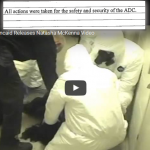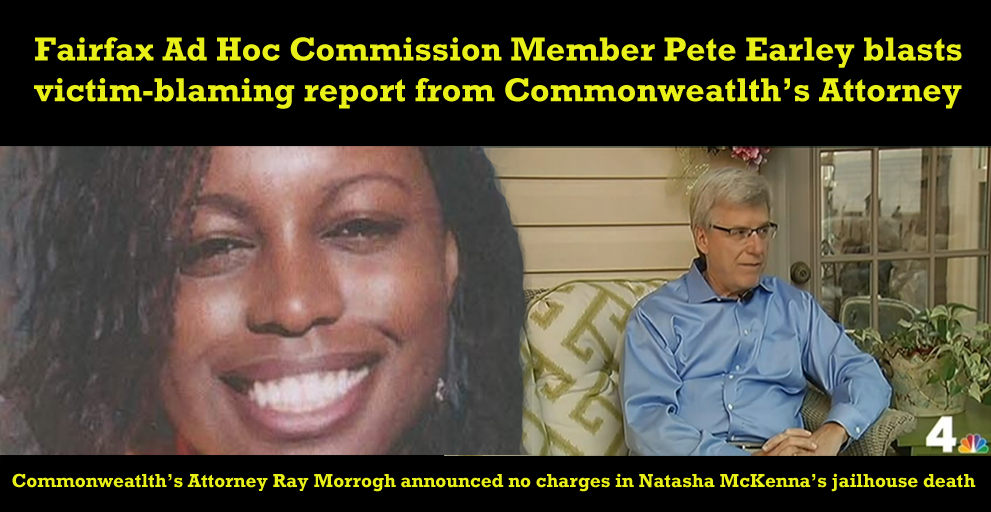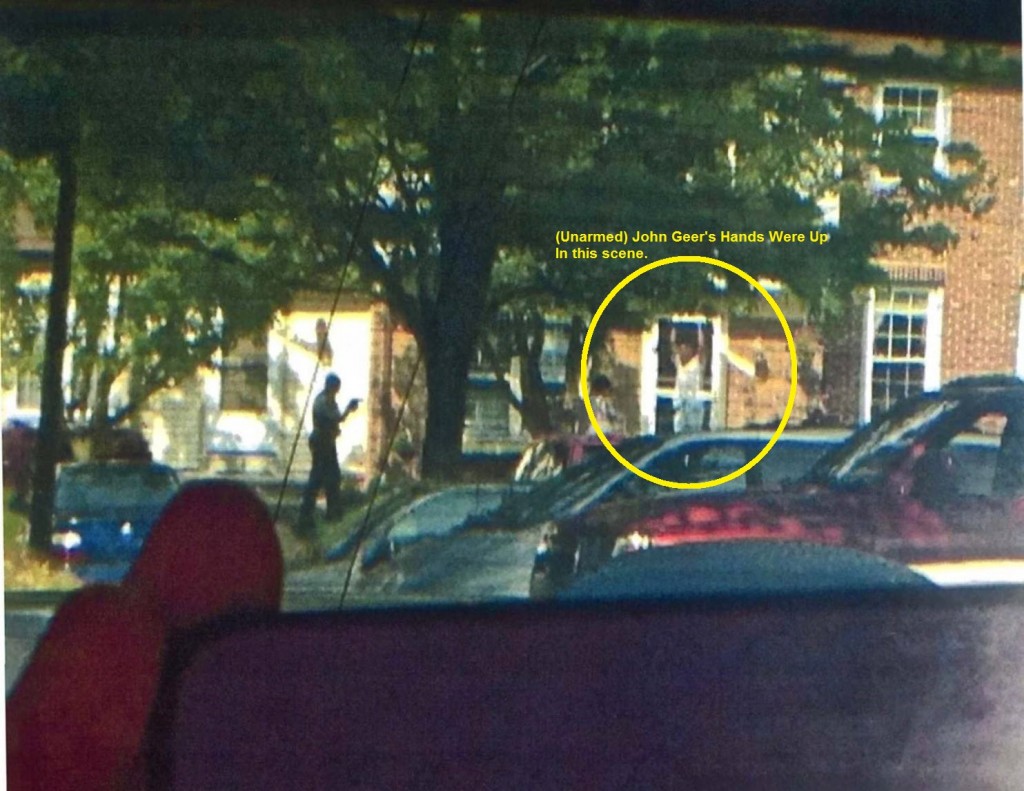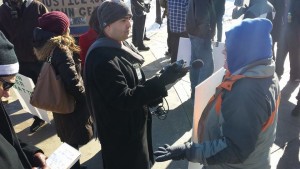
This is a long article, but I hope you will stick with me as I bring up many important points to bear in mind when discussing this case.
All Actions Were Taken For the Safety and Security of the Adult Detention Center
On Tuesday, Fairfax County Commonwealth’s Attorney Ray Morrogh announced that he will not be seeking charges against any of the six sheriff’s deputies involved in the death of Natasha McKenna. During a press conference Morrogh showed infinite sympathy to the deputies, “who are faced with a difficult job that most people don’t want to do.” He also bizarrely claimed that he “was not going to second guess people who are struggling with that situation,” even though his entire job as a prosecutor is to second guess people to determine potential guilt, particularly in incidents where a life has been lost. In the report he released that same day, Morrogh repeatedly rejects the idea that McKenna died due to the 4 Taser shocks she received, even going so far as to say that there’s never been a death directly caused by a Taser.
This is a setback for justice and police accountability in Fairfax County, but not really a surprise; The Adam Torres indictment Morrogh pursued last month is an anomaly in a career more commonly characterized by an unbefitting deference to law enforcement and an unwillingness to engage regarding deaths caused by its officers. The full faith and credit that some community members now eagerly credit him with are premature, especially amongst those concerned with overall police misconduct in Fairfax, and not merely the outcome of one individual case. Judgment about any supposed change of heart Morrogh has had should be reserved until after the Torres trial concludes and we see whether he puts on a vigorous prosecution to secure the guilty verdict the case deserves.
Surprisingly, the commonwealth’s attorney’s report and incident reports were released without redactions, revealing the names of the six sheriff’s deputies involved for the first time:
- Lucas Salzman (who used the Taser)
- Paul Miller
- Deputy Adam Henry
- Deputy Jonathan Perryman
- Deputy Patrick McPartlin
- Deputy Kenneth Krstulovic
Nearly all of the incident reports released by the sheriff’s office end with this telling line, “All actions taken were for the safety and security of the adult detention center.”
Background
All of the following is based on Morrogh’s report. When reading this very sympathetic to law-enforcement report, remember that we only know about this case because someone within the Fairfax County Sheriff’s Department was disturbed enough about what happened to leak the incident report to the media.
At age 37, Natasha McKenna had a long history of mental illness, with her first psychiatric hospitalization occurring at age 14. She has been diagnosed with schizophrenia, bipolar disorder, and depression. Despite apparently being competent enough to maintain her own apartment and car, McKenna has a series of instances of disturbing behavior and paranoid delusions at area hospitals and businesses between January 7th and January 15th. She has several encounters with police where she is subdued and taken into custody. She is also combative and physically aggressive when admitted to hospitals for psychiatric holds during this time.
On January 15th, Alexandria police respond to a disturbance at a local car rental agency, where they encounter McKenna and attempt to take her into custody again. A fight ensues after two police officers grab both of McKenna’s arms, and eventually 8 officers are involved in subduing her at various times. They use handcuffs, pepper spray, a hobble, a spit sock, and responding medics administer a sedative. She is charged with assaulting an officer for punching one of the officers during this incident.
She is eventually transported to INOVA Alexandria Hospital, where she continues to struggle and requires multiple officers to restrain her. She is transferred to the psychiatric ward at Mount Vernon Hospital where she remains under an emergency custody order until she is discharged on January 25th. During this stay medical professionals find many of the same health conditions uncovered during her earlier hospitalizations, rhabdomyolysis, leukocytosis, acute renal failure, and lactic acidosis.
She’s discharged at 12:30 PM on January 25th, and is brought to INOVA Fairfax Hospital by ambulance less than 8 hours later reporting a sexual assault. The Fairfax County police officers who investigate her report review video footage from the area where McKenna said the attack occur and don’t see any evidence of a assault. McKenna is discharged from the hospital and arrested for a warrant stemming from the January 15 assault charge on the Alexandria police officer. McKenna is taken to the Fairfax County Adult Detention Center (ADC), where she remains until the fatal incident on February 3, 2015.
The Fatal Incident and Natasha McKenna’s Feats of Legendary Superhuman Strength
“The propagandist’s purpose is to make one set of people forget that certain other sets of people are human.” — Aldous Huxley
The video of the incident is embedded below, if you can stomach scenes of extended senseless torture and abuse inflicted upon a terrified and helpless woman. If you do watch it, bear in mind the report’s extensive references to this petite woman’s “superhuman” and even demon-like strength, which law enforcement officers claim was sufficient to literally lift the multiple men lying on top of her off the ground. Also bear in mind that these statements seem to come from interviews after McKenna’s death, rather than from incident reports submitted the day of the encounters, which could have impacted the information provided. At any rate, see if you see any evidence of that superhuman strength in the video. I didn’t.
Not only does this characterization echo statements made by Darren Wilson regarding Mike Brown, it also serves to dehumanize and mythologize persons suffering from mental illness. It’s perfectly plausible that someone who suffers from disordered moods or thinking must somehow possess superhuman physical might that overpowers mere mortals such as ourselves, right?
Pete Earley, a noted journalist and advocate for the mentally ill, has an insightful article about this latest development in the case and the many lost opportunities for diversion from jail and to appropriate treatment that Natasha McKenna experienced in the last month of her life. He writes:
“On the day McKenna was repeatedly shocked with a 50,000 taser, she had agreed to not resist when she was first told that she was being transferred. In fact, she voluntarily agreed to be handcuffed. It was only after she saw a Sheriff’s Emergency Response Team waiting outside her cell that she panicked. The reason was obvious. Three days earlier, McKenna had clung to a mattress that deputies were attempting to drag out of her cell because she was using it to block a widow. She had clung onto it and actually been pulled from her cell into the hallway. At that point, she was struck several times on the head to force her back into her cell. Because of that incident, SERT was readied.
Morrogh’s report explains that the SERT team held a briefing before approaching the cell. His point was to show that the team’s approach was not haphazard. It was by the book. But it also could be argued that it shows the deputies had decided to use force to get her out of that cell regardless of how she reacted.”
In his report Morrogh states (emphasis mine): “In some cases, the presence of the SERT team dressed in all black or Tyvek can scare an individual. So, in an effort to keep Ms. McKenna calm, Lt. Miller approached the cell by himself at first…Lt. Miller stood at Ms. McKenna’s cell door (FR-2) and explained that deputies were there to move her out of her cell and take her to Alexandria… At that moment Ms. McKenna appeared to Lt. Miller to be rational. He asked her if she would cooperate and she said, “Fine.” It was Lt. Miller’s goal to obtain Ms. McKenna’s voluntary compliance with the process and avoid the use of force. Based upon her response, he believed she would be compliant. He asked her to put her arms out of the food slot so that he could hand cuff her. She said “okay” and complied. Lt. Miller handcuffed her and applied the rip hobble to the handcuffs so that Ms. McKenna could not withdraw her hands.”
An aside, but if you’ve watched the video, you know that Ms. McKenna was naked during this incident. One wonders why Lt. Miller didn’t bother asking her if she would like to put clothing on before they took her out into the hallway in front of the numerous jail staff present. They were transporting her to Alexandria in the middle of winter, apparently with the intention to only loosely drape a smock over her as covering.
This is completely glossed over in the report, but McKenna was transported without incident on at least two separate occasions (once by a single officer):
- “On January 17, 2015 an Alexandria police officer picked up the Emergency Custody Order and served it on Ms. McKenna. He then transported her from INOVA Alexandria hospital to the psychiatric unit at Mount Vernon Hospital.”
- On January 25th, “Fairfax Hospital cleared Ms. McKenna for release and officers arrested her on an outstanding warrant from Alexandria City.”
Knowing that McKenna was cooperative at the outset of this interaction, had recent incidents where she fully cooperated with law enforcement officers during transport, and that she had paranoid ideation about police officers trying to kill her, why did Lt. Miller think bringing a squad of masked, hazmat-suited goons into the situation would do anything other than terrify and antagonize Ms. McKenna? Indeed, her first words upon seeing the SERT team are, “You promised you wouldn’t kill me! I didn’t do anything.”
In the report, Morrogh goes over in great detail the training the sheriff’s deputies received as part of the Sheriff’s Emergency Response Team and in using tasters, but doesn’t indicate whether any of them had received Crisis Intervention Training for dealing with mentally ill persons in crisis. The report also notes the many times they told Ms. McKenna to “stop resisting,” but doesn’t question why none of them bothered to ask themselves if they should stop escalating the situation. Compliance at any cost was their objective that day, and the cost was Natasha McKenna’s life.
Excited Delirium, a.k.a “Anything but the Taser” Syndrome
Morrogh also details McKenna’s numerous health issues prior to her arriving at the jail, and concludes that they indicate the “excited delirium” listed as the cause of death by the medical examiner. He also claims in the press conference video that he has never heard of a death being caused by a Taser. That’s curious since in his report he argues that McKenna could not have died as a result of being shocked with the Taser because, “if death is due to ventricular fibrillation or asystole produced by the Taser pulse, then the individual would lose consciousness immediately (3 to 4 seconds up to a maximum of 10 to 15 seconds),” and “McKenna was conscious for several minutes after the last deployment of the Taser.”
We don’t see McKenna for most of the time while she is being tased, so we don’t really know for sure that she is conscious the entire time. The quote above seems to imply that individuals succumbing to ventricular fibrillation or asystole would at least temporarily revive and return to consciousness. In that scenario, McKenna could have lost consciousness (like when she goes limp enough for the deputies to move her around like a ragdoll on the restraint chair) after any of the four shocks, and not just the final one.
Another reason it is unlikely Morrogh had not heard of Tasers being potentially lethal instruments is that he specifically references the ECW guidelines published by the Police Executive Research Forum (PERF) in 2011. It’s possible that even though he was in the middle of a high-profile criminal investigation regarding use of deadly force, Morrogh may have been uninterested in the results of the use of force policy review that Fairfax County Government paid PERF $80,000 to do this year, but I’d guess their report probably landed on his desk at least once.
At any rate, PERF representatives presented the results of their review at a meeting of the Fairfax ad hoc commission to review police practices and took care to emphasize that Tasers are not non-deadly, but merely “less lethal” devices. They also stressed that Tasers should not be used to deliver more than 3 successive shocks, which is in keeping with guidelines from the manufacturer.
Key recommendations from PERF’s 2011 ECW Guidelines:
- Personnel should be trained to use an ECW for one standard cycle (five seconds) and then evaluate the situation to determine if subsequent cycles are necessary. Training protocols should emphasize that multiple applications or continuous cycling of an ECW resulting in an exposure longer than 15 seconds (whether continuous or cumulative) may increase the risk of serious injury or death and should be avoided.16. Agencies’ policy and training should discourage the use of the drive stun mode as a pain compliance technique. The drive stun mode should be used only to supplement the probe mode to complete the incapacitation circuit, or as a countermeasure to gain separation between officers and the subject so that officers can consider another force option.
- Personnel should use an ECW for one standard cycle (five seconds) and then evaluate the situation to determine if subsequent cycles are necessary. Personnel should consider that exposure to the ECW for longer than 15 seconds (whether due to multiple applications or continuous cycling) may increase the risk of death or serious injury. Any subsequent applications should be independently justifiable, and the risks should be weighed against other force options.
- All subjects who have been exposed to ECW application should receive a medical evaluation by emergency medical responders in the field or at a medical facility. Subjects who have been exposed to prolonged application (i.e., more than 15 seconds) should be transported to an emergency department for evaluation. Personnel conducting the medical evaluation should be made aware that the suspect has experienced ECW activation, so they can better evaluate the need for further medical treatment.
In the unlikely possibility that Morrogh actually was in the dark about Electronic Control Weapon (ECW) deaths, it could be because TASER International, Inc has successfully sued medical examiners who concluded that people had died as a result of being tased.
A Slate article informs us that TASER International has taken a more proactive approach in steering medical examiners away from attributing deaths to the devices they manufacture:
At a Canadian public inquiry set up in 2008 to study the appropriateness of allowing cops to use Tasers, Mike Webster, a police psychologist, went further. He blamed Taser International for “brainwashing” cops and testified that “police and medical examiners are using the term [excited delirium] as a convenient excuse for what could be excessive use of force or inappropriate control techniques during an arrest.” He went on to add that members of the law enforcement community “have created a virtual world replete with avatars that wander about with the potential to manifest a horrific condition characterized by profuse sweating, superhuman strength, and a penchant for smashing glass that appeals to well-meaning but psychologically unsophisticated police personnel.”
The ACLU and other organizations have noted that the excited delirium diagnosis is virtually non-existent outside of in-custody deaths. It is not a diagnosis recognized in the American Psychiatric Association’s Diagnostic and Statistical Manual of Mental Disorders (DSM-IVTR) or the International Classification of Diseases (ICD-9) system used by all US healthcare agencies and insurers. It seems to exist solely as a convenient cover to excuse gross mistreatment and abuse of mentally ill persons who die in police custody.
Pete Earley points out:
“if you check the 2012 and 2013 annual statistical reports issued by the Office of the Chief Medical Examiner in Virginia you will not find a single mention of excited delirium as a cause of death in the state. It is not listed as a cause of any death in Virginia during 2013 in the 128 in-custody deaths that were examined by that office. Not one incident. Nor is it cited in the deaths of 60 persons with mental illnesses who were examined. Not one incident. In the entire 238 page annual report in 2013, there is absolutely no mention of a death in Virginia that was attributed to excited delirium.
The diagnosis can be traced back to 1849, the same time period that physicians were declaring that enslaved African Americans who tried to escape captivity did so because they suffered from a mental illness called drapetomania. Today we immediately recognize this as self-serving pseudoscience conjured up to defend the inhumane treatment of an oppressed group. Excited delirium is a companion piece of shameful quackery that should also be relegated to the dustbin of history.
Natasha McKenna’s Health Status and Fairfax County Sheriff’s Department ECW Policy
According to a 2009 white paper from the American College of Emergency Physicians cited in Morrogh’s report:
“ Most persons suffering from excited delirium are hyper-aggressive, impervious to pain, and demonstrate unusual, ‘superhuman’ strength. They engage in a lengthy period of struggle, followed by a period of quiet and sudden death…. Severe acidosis appears to play a prominent role in lethal [excited delirium] ExDS associated cardiovascular collapse.”
So we know from the above that acidosis is thought to contribute to excited delirium deaths, and from Natasha McKenna’s medical records that she already had acidosis, diabetes insipidus (a metabolic disorder), and an elevated heart rate prior to arriving at the county jail. We also see that the warnings from TASER International state using the Taser can produce physiologic or metabolic effects regarding acidosis, creatine kinase, lactic acid, catecholamines, and heart rate, among other effects.
So basically the Taser manual states that it can affect the same factors that excited delirium proponents say are thought to cause people to die from excited delirium.
In addition, the manual goes on to warn that individuals who are physiologically or metabolically compromised may be more susceptible to arrest-related death, and lists acidosis as a factor that can increase this susceptibility. It urges users to follow their agency’s guidance for dealing with physiologically/metabolically compromised persons.
SOP 525, the Fairfax County Sheriff Department’s policy for Electronic Control Devices states that prior to using a Taser:
ADC Medical Staff will be notified to ensure that the individual is not:
- pregnant
- known to have heart disease
- known to have Multiple Sclerosis
- known to have Muscular Dystrophy
Acidosis and being physiologically or metabolically compromised aren’t on this list, but it still states that medical staff should be contacted prior to using the Taser. The SERT team arrived at McKenna’s cell with the Taser already in hand, so they were aware it might be used. Did they consult with medical staff as directed by policy? It’s not recorded in Morrogh’s report nor in the incident report that they did. If they had, would the ADC medical staff have cleared the SERT team to use an ECW on an inmate with such concerning health status as Natasha McKenna?
The ECW policy also states, “medical attention will be given to any subject who has been stunned as soon as possible and when safe to do so,” and “the inmate will be examined by Medical personnel as soon as practical.” While members of the SERT team did inform medical staff that McKenna had been shocked 4 times, and vitals were initially obtained within a few minutes of the final Taser deployment, there is a long stretch where she appears motionless in the video, and is not evaluated again until it is time to put her in the transport van. Rescue is not requested for another 7 minutes after that.
While PERF guidelines state that a person who has been tasered for longer than 15 seconds should be taken to an emergency room for evaluation, and McKenna had been subjected to a cumulative 20 seconds of tasering, the transport plan was still to take her to the Alexandria City jail rather then a hospital. It does not appear that any of the medical staff were going to accompany McKenna to provide care and monitoring during transport. It’s not known if there was a formal process for staff at the Alexandria jail to be informed of the tasering incident and McKenna’s need for medical evaluation once she was transferred to them. These are aspects that will probably be explored in the civil lawsuit that will almost assuredly be materializing in this case.
In the meantime, taser use has been suspended at the ADC, the Department of Justice’s investigation into the case continues, and Fairfax County officials’ crocodile tears over unnecessary deaths at the hands of the police flow once again.
A protest regarding the outcome of this case is planned for Monday, September 14th at 7:00 PM, right before the final public comment session of the Fairfax ad hoc commission.

































